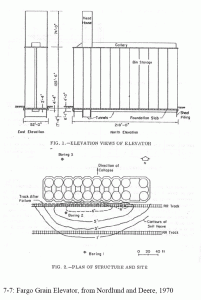The Transcona Grain Elevator collapsed in 1913, and the Fargo Grain Elevator collapsed in 1955, with almost identical failure mechanisms. They were similar structures founded on similar types of soil. The two cases provided important confirmations of soil bearing capacity calculations.
Transcona Grain Elevator
Construction of the elevator started in 1911. It consisted of a work house and a bin house. The work house was 21 by 29 m (70 by 96 ft) in the plan, and 55 m (180 ft) high, with a raft foundation 3.7 m (12 ft) below the surface. The bin house had 13 bins, each approximately 28 m (92 ft) high and 4.3 m (14 ft) in diameter. The bins rested on a reinforced concrete raft foundation, 23.5 m (77 ft) wide and 59.5 m (195 ft) long, also at a depth 3.7 m (12 ft) below the surrounding soil. The underlying soil was a layer of stiff blue clay, roughly 6 to 11 m (20 to 35 ft) thick (Peck and Bryant 1953).
Small plate load tests were performed before construction. These indicated that the soil should be able to bear a pressure of 383 to 479 kPa (4 to 5 tsf or ton per square foot). The total pressure with the warehouse filled with grain would be no more than 316 kPa (3.3 tsf) (Morley 1996, p. 26).
The structure was finished in September 1913 and began to be filled with grain as uniformly as possible. On October 18, 1913, the bins were about 88 % full, and the settlement was observed, increasing within an hour to a uniform 300 mm (1 ft). Over the next 24 hours, the structure tilted to the west by nearly 27. Surprisingly, the bin house remained intact through the rotation (Peck and Bryant 1953).
The development of soil mechanics after the Transcona failure eventually provided a basis for computing the ultimate bearing capacity of soils. It was subsequently realized, therefore, that the Transcona failure served as a full-scale check of the validity of such computations. (Shepherd and Frost 1995, p. 5).
Fargo Grain Elevator
The Fargo Grain Elevator collapsed 42 years after the Transcona Grain Elevator. Major filling began in April 1955, and the collapse occurred on June 12, 1955. The structure broke apart and was completely destroyed in the collapse. It collapsed in the northward direction, forming a mass of concrete rubble and grain with soil heaved up on the south side as much as 1.8 m (6 ft). Like the Transcona Grain Elevator, the Fargo structure was part of the ancient Lake Aggassiz clay deposits that stretch across much of the northern Great Plains of North America (Nordlund and Deere, 1970). Figure 7-7 shows the elevation and plan of the failed grain elevator.
The Fargo Grain Elevator was a reinforced concrete structure comprising 20 circular bins and 26 small interstitial bins. The circular bins, arranged in two rows of 10 bins each, were 5.8 m (19 ft) in diameter and 37 m (122 ft) high. The foundation was a reinforced concrete raft 16 m (52 ft) wide, 66 m (218 ft) long, and 0.7 m (2 ft 4 in) thick. It was thus narrower but longer than the Transcona Grain Elevator, with about 75 % of the capacity. The edge of the foundation was thickened, and the bottom of the raft was 1.8 m (6 ft) below grade excluding the thickened edges. Steel sheet piling was also driven around the edges of the foundation (Nordlund and Deere, 1970).
Settlement readings were taken on the raft foundation starting on May 10, 1955, a month before the collapse. Seven elevation benchmarks were established, and readings were taken once per week. There was no record of any possible settlement before the benchmarks were established. Settlements increased dramatically over the week and a half before the collapse, reaching 222- 308 mm (8.75-12.13 in). It is clear that a day-to-day plot of these data would have given clear warning of the impending failure (Nordlund and Deere, 1970, p. 589).
References
The complete case studies are provided in Chapter 7 of Beyond Failure: Forensic Case Studies for Civil Engineers. The two-grain elevator failures occurred 42 years apart, and the landmark papers analyzing the failures were written nearly two decades apart. In each case, the authors went into great detail concerning their field sampling and laboratory testing procedures, as well as the methods they developed to estimate the shear strength of the soils. Readers interested in those details should obtain and read the original references.
The key references on these cases are by Peck and Bryant (1953) on the Transcona Elevator and by Nordlund and Deere (1970) on the Fargo Elevator. Morley (1996) discusses the significance of Transcona and other cases in the development of geotechnical and foundation engineering as a discipline.
Peck, R.B., and Bryant, F.G. (1953) The Bearing-Capacity Failure of the Transcona Elevator, Geotechnique, Vol. 3, pp. 201- 208.
Nordlund, R.L, and Deere, D.U. (1971) The collapse of the Fargo Grain Elevator, ASCE Journal of the Soil Mechanics and Foundations Division, Vol. 96, No. SM2, pp. 585-607, March 1970.
Illustrations from Chapter 7 of the book Beyond Failure: Forensic Case Studies for Civil Engineers, Delatte, Norbert J., ASCE Press.






